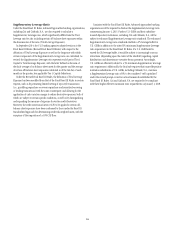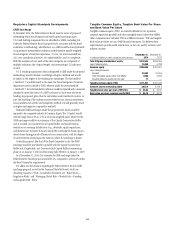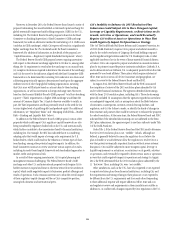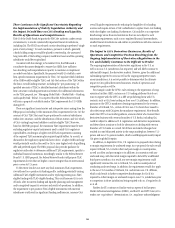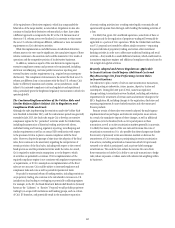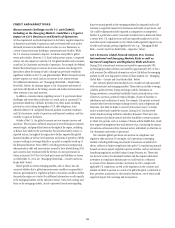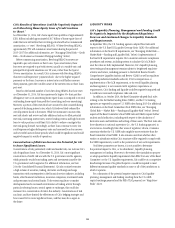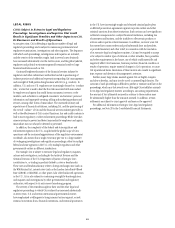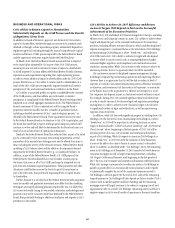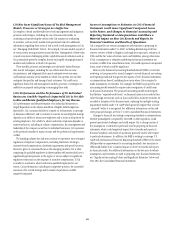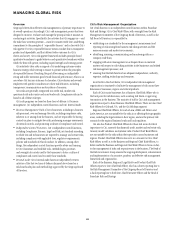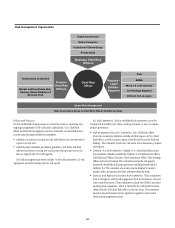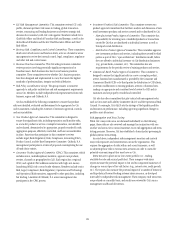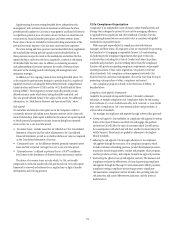Citibank 2014 Annual Report Download - page 78
Download and view the complete annual report
Please find page 78 of the 2014 Citibank annual report below. You can navigate through the pages in the report by either clicking on the pages listed below, or by using the keyword search tool below to find specific information within the annual report.61
LEGAL RISKS
Citi Is Subject to Extensive Legal and Regulatory
Proceedings, Investigations and Inquiries That Could
Result in Significant Penalties and Other Impacts on Citi,
Its Businesses and Results of Operations.
At any given time, Citi is defending a significant number of legal and
regulatory proceedings and is subject to numerous governmental and
regulatory examinations, investigations and other inquiries. The frequency
with which such proceedings, investigations and inquiries are initiated,
and the severity of the remedies sought (and in several cases obtained),
have increased substantially over the last few years, and the global judicial,
regulatory and political environment generally remains hostile to large
financial institutions such as Citi.
Continued heightened scrutiny of the financial services industry by
regulators and other enforcement authorities has led to questioning of
industry practices and additional expectations regarding Citi’s management
and oversight of third parties doing business with Citi (e.g., vendors). In
addition, U.S. and non-U.S. regulators are increasingly focused on “conduct
risk,” a term that is used to describe the risks associated with misconduct
by employees and agents that could harm consumers, investors, or the
markets, such as failures to safeguard consumers’ and investors’ personal
information and improperly creating, selling and marketing products and
services, among other forms of misconduct. The increased scrutiny and
expectations of financial institutions, including Citi, and the questioning of
the overall “culture” of Citi and the financial services industry generally as
well as the effectiveness of Citi’s control functions, has and could continue to
lead to more regulatory or other enforcement proceedings. While Citi takes
numerous steps to prevent and detect misconduct by employees and agents,
misconduct may not always be deterred or prevented.
In addition, the complexity of the federal and state regulatory and
enforcement regimes in the U.S., coupled with the global scope of Citi’s
operations and the continued aggressiveness of the regulatory environment
worldwide, also means that a single event may give rise to a large number
of overlapping investigations and regulatory proceedings, either by multiple
federal and state agencies in the U.S. or by multiple regulators and other
governmental entities in different jurisdictions.
For example, Citi is subject to extensive legal and regulatory inquiries,
actions and investigations, including by the Antitrust Division and the
Criminal Division of the U.S. Department of Justice, relating to Citi’s
contribution to, or trading in products linked to, rates or benchmarks.
These rates and benchmarks may relate to foreign exchange rates (such as
the WM/Reuters fix), interest rates (such as the London Inter-Bank Offered
Rate (LIBOR) or ISDAFIX), or other prices. Like other banks with operations
in the U.S., Citi is also subject to continuing oversight by bank regulators,
and inquiries and investigations by other governmental and regulatory
authorities, with respect to its anti-money laundering program.
The severity of the remedies sought in these and the other legal and
regulatory proceedings to which Citi is subject has increased substantially
in recent years. U.S. and certain international governmental entities
have emphasized a willingness to bring criminal actions against, or seek
criminal convictions from, financial institutions, and criminal prosecutors
in the U.S. have increasingly sought and obtained criminal guilty pleas
or deferred prosecution agreements against corporate entities and other
criminal sanctions from those institutions. Such actions can have significant
collateral consequences for a subject financial institution, including loss
of customers and business, and the inability to offer certain products or
services and/or operate certain businesses. In addition, in recent years Citi
has entered into consent orders and paid substantial fines and penalties,
or provided monetary and other relief, in connection with the resolution
of its extensive legal and regulatory matters. Citi may be required to accept
or be subject to similar types of criminal or other remedies, fines, penalties
and other requirements in the future, any of which could materially and
negatively affect Citi’s businesses, business practices, financial condition or
results of operations, require material changes in Citi’s operations, or cause
Citi reputational harm. Resolution of these matters also results in significant
time, expense and diversion of management’s attention.
Further, many large claims asserted against Citi are highly complex
and slow to develop, and may involve novel or untested legal theories. The
outcome of such proceedings is difficult to predict or estimate until late in the
proceedings, which may last several years. Although Citi establishes accruals
for its legal and regulatory matters according to accounting requirements,
the amount of loss ultimately incurred in relation to those matters may
be substantially higher than the amounts accrued. In addition, certain
settlements are subject to court approval and may not be approved.
For additional information relating to Citi’s legal and regulatory
proceedings, see Note 28 to the Consolidated Financial Statements.


